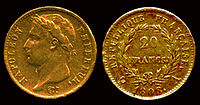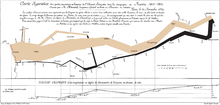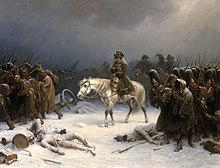| Gold 20 Franc Coin of Napoleon I, struck 1808 |
 |
| Known as Napoleon Gold, the French began to simply call these coins, "Napoleons." Obverse: (French) NAPOLEON EMPERERUR, or in English, "Napoleon, Emperor"" | Reverse: (French) REPUBLIQUE FRANÇAISE, 1808, 20 FRANCS, or in English, "French Republic, 1808, 20 Francs." |
The
Congress of Erfurt sought to preserve the Russo-French alliance, and the leaders had a friendly personal relationship after their first meeting at Tilsit in 1807.
By 1811, however, tensions had increased and Alexander was under pressure from the
Russian nobility to break off the alliance. An early sign the relationship had deteriorated was the Russian's virtual abandonment of the Continental System, which led Napoleon to threaten Alexander with serious consequences if he formed an alliance with Britain.
By 1812, advisers to Alexander suggested the possibility of an invasion of the French Empire and the recapture of Poland. On receipt of intelligence reports on Russia's war preparations, Napoleon expanded his
Grande Armée to more than 450,000 men.
He ignored repeated advice against an invasion of the Russian heartland and prepared for an offensive campaign; on 23 June 1812 the invasion commenced.
In an attempt to gain increased support from Polish nationalists and patriots, Napoleon termed the war the
Second Polish War—the
First Polish War had been the
Bar Confederation uprising by Polish nobles against Russia in 1768. Polish patriots wanted the Russian part of Poland to be joined with the Duchy of Warsaw and an independent Poland created. This was rejected by Napoleon, who stated he had promised his ally Austria this would not happen. Napoleon refused to
manumit the Russian
serfs because of concerns this might provoke a reaction in his army's rear. The serfs later committed atrocities against French soldiers during France's retreat.
The Russians avoided Napoleon's objective of a decisive engagement and instead retreated deeper into Russia. A brief attempt at resistance was made at
Smolensk in August; the Russians were defeated in a series of battles, and Napoleon resumed his advance. The Russians again avoided battle, although in a few cases this was only achieved because Napoleon uncharacteristically hesitated to attack when the opportunity arose. Owing to the Russian army's
scorched earth tactics, the French found it increasingly difficult to forage food for themselves and their horses.

Charles Joseph Minard's graph shows the decreasing size of the
Grande Armée as it marched to Moscow and back
The Russians eventually offered battle outside Moscow on 7 September: the
Battle of Borodino resulted in approximately 44,000 Russian and 35,000 French dead, wounded or captured, and may have been the bloodiest day of battle in history up to that point in time.
Although the French had won, the Russian army had accepted, and withstood, the major battle Napoleon had hoped would be decisive. Napoleon's own account was: "The most terrible of all my battles was the one before Moscow. The French showed themselves to be worthy of victory, but the Russians showed themselves worthy of being invincible."
The Russian army withdrew and retreated past Moscow. Napoleon entered the city, assuming its fall would end the war and Alexander would negotiate peace. However, on orders of the city's governor
Feodor Rostopchin, rather than capitulation, Moscow was burned. After a month, concerned about loss of control back in France, Napoleon and his army left.
The French suffered greatly in the course of a ruinous retreat, including from the harshness of the
Russian Winter. The Armée had begun as over 400,000 frontline troops, but in the end fewer than 40,000 crossed the
Berezina River in November 1812.
The Russians had lost 150,000 in battle and hundreds of thousands of civilians.



0 comments:
Post a Comment